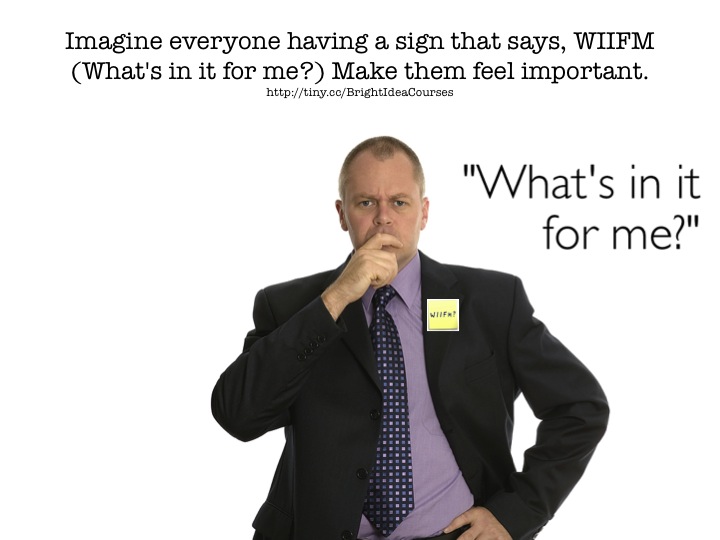The first rule is to address WIIFM. If you don't get the attention of your audience by answering what's in it for me don't read any further.
1. Anticipate and Address Objections:
Investors can be “Doubting Thomases.” Ask yourself, “Why would they say no?” and then say that early on. If you don’t bring up their objections in the beginning, they won’t be listening; they’ll be waiting for you to stop talking so they can tell you why this won’t work. Neutralize resistance by naming it . . . first.
2. Title Each Slide with the Main Point:
Don’t distract investors by forcing them to figure out the most important take-away. They can’t give you their undivided attention if they’re confused by an unclear slide. Ask, “What do I want them to remember from this slide?” and feature it without clutter.
3. Show Them the Money:
Want investors to give you millions? Show exactly how and where you’ve managed and made millions before. Where exactly have you produced impressive monetary results commensurate with what you’re asking? Prove you’re not a risk with a tangible, bottom-line track record of successful launches, exits, sales, profits, savings, payoffs.
Don’t wait until the last slide to introduce this. Put it up front as the primary question in an investor’s mind is, “Have you generated big money before? Can you be trusted to do it again and make me money? How?”
4. Turn Some of Your Titles into Questions:
Posing and answering questions turns your pitch into a two-way dialogue instead of a one-way lecture. Voicing what the group is thinking serves as a verbal bridge where you articulate what’s on their mind and then address their question.
5. State the Problem(s) Your Business Solves:
Exactly how does your business solve a major, existing problem of your target audience in unique or more efficient, profitable ways? State the size and scope of the problem. How is your solution better than the competition? What are you introducing that is revolutionary, first-of-its-kind? Provide metrics of your scalability.
6. Videotape yourself giving the pitch and watch it with team members.
Clarify your goal. What do you want decision-makers to do at the end of your pitch? Ask yourself, “Will they take the desired action at the end of this pitch? What will they remember? Will they be sufficiently impressed to ask for a follow-up meeting?” If not, it’s back to the drawing board. (Or, as George Carlin used to say, “What did we go back to before there were drawing boards?”)
7. 10 to 12 slides TOPS.
People shut down when there’s too many slides and a speaker rushes to “get them all in.” When people can’t grasp info because they’re overwhelmed; they’re not going to say yes or want to know more. Discipline yourself to make 10 clean points. vs. 20 confusing ones.
8. Remember, slides are visual “aids.”
In a 10 minute pitch, fancy animation, sound clips, complex graphics or over-use of gaudy colors can be over-kill. YOU are the show – not your slides. Please, no lengthy documents in tiny print. Discipline yourself to make every word tell. Distill crucial info into 1 or 2 line bullet points with 10 words or less.
Make copy easy to “eyeball” with a minimum of 30 point font. Instead of bells and whistles; use a consistent theme with dark text on a light background to produce an easy-to-read, professional-looking presentation.
9. Number points on slides and distill each point into a 1 or 2 line sound-byte.
Elmore Leonard said, “I try to leave out the parts people skip.” Have a max of 25 words per slide. Distill each point into its essence – you can always elaborate when you’re speaking. Numbering points instead of bulleting them can make them easier to follow and more factual.
10. Make Your Slides Right and Left Brain:
Include some human faces along with your graphics and grids. Balance statistics with a real-life success story to “people” your pitch so it’s not neck-up, wah-wah rhetoric. Remember, investors make decisions on emotion and logic. Do they like you and your venture and have you backed up your projections with empirical data?
11. Put Names and Numbers in Your Claims:
Instead of making vague generalizations (e.g., “team has extensive experience in bio-med” What’s that mean?), say, “For example . . . “ and then featue the names and logos of companies you’ve worked with; the millions of dollars you’ve generated; the hundreds of people you’ve managed. Metrics are trusted. Sweeping claims without specific, real-world evidence are suspect.
12. Ask for Action in Closing Slide:
Don’t trail off and expect the audience to read your mind and know what you want. What do you want them to do? Call to set up a follow-up meeting? Connect with you at your exhibit table? Request a free sample or demo? Be explicit.



